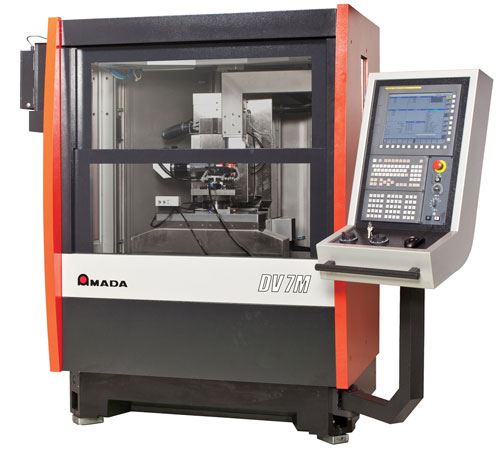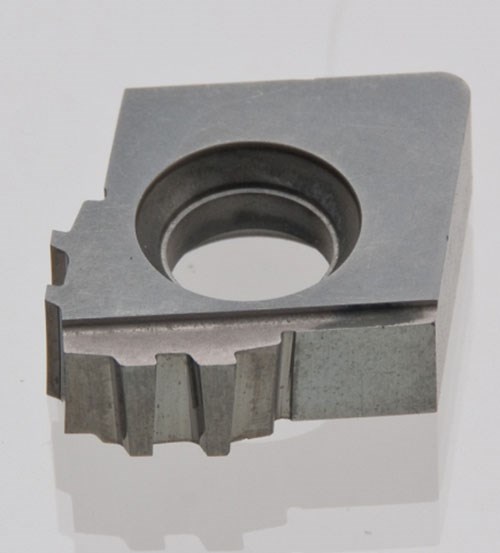On a conventional optical profile grinder, the expert grinding machine operator uses a magnified image of a contour as a guide for controlling the path and orientation of the grinding wheel. The DV-7M reciprocating CNC profile grinder from
Amada Machine Tools America (Schaumburg, Illinois) uses a digital profile derived from a CAD file to replace the chart or overlay required for optical profile grinders. After downloading the CAD file to the DV-7M’s CNC (a FANUC 31i-Model A), the operator applies reliefs and related geometry to the basic part profile in a Windows interface. The onboard CAM system then creates the corresponding tool path with multi-axis control of the grinding wheel to produce the profile.
After automatically setting the swiveling wheel to the workpiece edge, the CAM software continuously monitors the as-ground workpiece profile and compares it to the CAD model. The built-in vision system helps the user detect departures from the nominal profile and identifies offset adjustments required to compensate. This virtually eliminates inaccuracies resulting from factors such as wheel wear, for example, developers say.
In addition, following an optimized, programmed grinding routine produces workpiece edges with smooth, blended reliefs and rake angles. Equipped with as many as seven axes, this machine can use swinging wheel motions to grind a tool’s cutting reliefs from multiple directions. When applied to form tools such as the one pictured on the previous page, these ground edges prolong cutter life and leave finer surface finishes. Form tools with these ground edges are said to outperform those with wire EDMed edges.
However, the DV-7M is designed to grind many types of precision workpieces in addition to form-cutting tools. The range of possibilities extends from gear hobs to cylindrical crush rolls to punches and dies. It will do profile grinding, creepfeed grinding, and cylindrical grinding, and it can produce complex relief angles, including logarithmic reliefs for hobs and similar cutting tools.
According to the company, the grinder is suitable for a range of workpiece materials, including tool steel, graphite, copper, carbide and ceramics. It is designed to use both superabrasive (cubic boron nitride) and diamond grinding wheels.
The grinder features a vibration-damping polymer/mineral base with internal cooling,
hydrostatic ways, and linear motors. Modular machine elements that tilt, swing and rotate are available for additional axes of simultaneous control. Workpieces can be loaded and unloaded automatically. Likewise, grinding wheels can be exchanged automatically.
Related Content
-
After more than 40 years in business, this shop has learned how to adapt to stay profitable.
-
Determining the currently active work offset number is practical when the program zero point is changing between workpieces in a production run.
-
In the late 1800s, a new technology — Swiss-type machines — emerged to serve Switzerland’s growing watchmaking industry. Today, Swiss-machined parts are ubiquitous, and there’s a good reason for that: No other machining technology can produce tiny, complex components more efficiently or at higher quality.

























